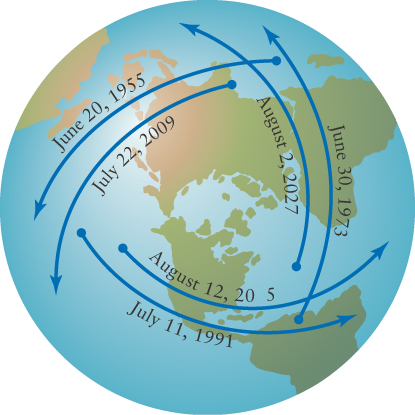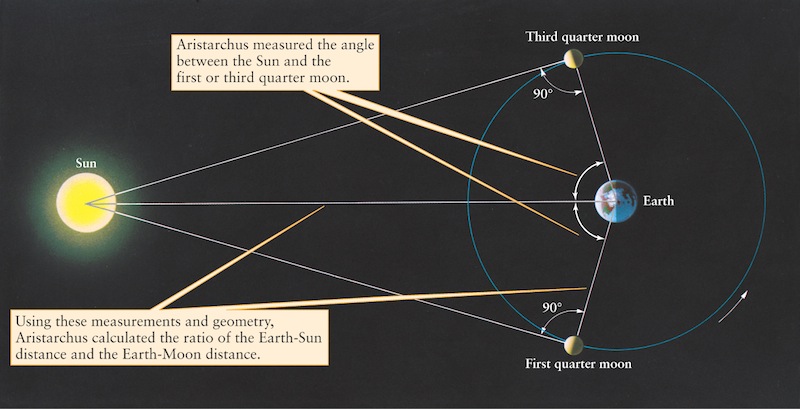3-6 Ancient astronomers measured the size of Earth and attempted to determine distances to the Sun and Moon
The ideas of geometry made it possible for Greek scholars to estimate cosmic distances
The prediction of eclipses was not the only problem attacked by ancient astronomers. More than 2000 years ago, centuries before sailors of Columbus’s era crossed the oceans, Greek astronomers were fully aware that Earth is not flat. They had come to this conclusion using a combination of observation and logical deduction, much like modern scientists. The Greeks noted that during lunar eclipses, when the Moon passes through Earth’s shadow, the edge of the shadow is always circular. Because a sphere is the only shape that always casts a circular shadow from any angle, they concluded that Earth is spherical.
59
TOOLS OF THE ASTRONOMER’S TRADE
Predicting Solar Eclipses
Suppose that you observe a solar eclipse in your hometown and want to figure out when you and your neighbors might see another eclipse. How would you begin?
First, remember that a solar eclipse can occur only if the line of nodes points toward the Sun at the same time that there is a new moon (see Figure 3-7). Second, you must know that it takes 29.53 days (one synodic month) to go from one new moon to the next. Because solar eclipses occur only during new moon, you must wait several whole lunar months for the proper alignment to occur again.
However, there is a complication: The line of nodes gradually shifts its position with respect to the background stars. It takes 346.6 days to move from one alignment of the line of nodes pointing toward the Sun to the next identical alignment. This period is called the eclipse year.
Therefore, to predict when you will see another solar eclipse, you need to know how many whole lunar months equal some whole number of eclipse years. This information will tell you how long you will have to wait for the next virtually identical alignment of the Sun, the Moon, and the line of nodes. By trial and error, you find that 223 lunar months is the same length of time as 19 eclipse years, because
223 × 29.53 days = 19 × 346.6 days = 6585 days
This calculation is accurate to within a few hours. A more accurate calculation gives an interval, called the saros, that is about one-third of a day longer, or 6585.3 days (18 years, 11.3 days). Eclipses separated by the saros interval are said to form an eclipse series.
You might think that you and your neighbors would simply have to wait one full saros interval to go from one solar eclipse to the next. However, because of the extra one-third day, Earth will have rotated by an extra 120° (one-third of a complete rotation) when the next solar eclipse of a particular series occurs. The eclipse path will thus be one-third of the way around the world from you. Therefore, you must wait three full saros intervals (54 years, 34 days) before the eclipse path comes back around to your part of Earth. The illustration shows a series of six solar eclipse paths, each separated from the next by one saros interval.
There is evidence that ancient Babylonian astronomers knew about the saros interval. However, the discovery of the saros is more likely to have come from lunar eclipses than solar eclipses. If you are far from the eclipse path, there is a good chance that you could fail to notice a solar eclipse. Even if half the Sun is covered by the Moon, the remaining solar surface provides enough sunlight for the outdoor illumination not to be greatly diminished. By contrast, anyone on the nighttime side of Earth can see an eclipse of the Moon unless clouds block the view.

60
Eratosthenes and the Size of Earth

Around 200 b.c.e., the Greek astronomer Eratosthenes devised a way to measure the circumference of the spherical Earth. It was known that on the date of the summer solstice (the first day of summer; see Section 2-5) in the ancient town of Syene in Egypt, near present-day Aswan, the Sun shone directly down the vertical shafts of water wells. Hence, at local noon on that day, the Sun was at the zenith (see Section 2-4) as seen from Syene. Eratosthenes knew that the Sun never appeared at the zenith at his home in the Egyptian city of Alexandria, which is on the Mediterranean Sea almost due north of Syene. Rather, on the summer solstice in Alexandria, the position of the Sun at local noon was about 7° south of the zenith (Figure 3-14). This angle is about one-fiftieth of a complete circle, so he concluded that the distance from Alexandria to Syene must be about one-fiftieth of Earth’s circumference.
In Eratosthenes’s day, the distance from Alexandria to Syene was said to be 5000 stades. Therefore, Eratosthenes found Earth’s circumference to be
50 × 5000 stades = 250,000 stades
Unfortunately, no one today is sure of the exact length of the Greek unit called the stade. One guess is that the stade was about one-sixth of a kilometer, which would mean that Eratosthenes obtained a circumference for Earth of about 42,000 kilometers. This is remarkably close to the modern value of 40,000 kilometers.
Aristarchus and Distances in the Solar System
Eratosthenes was only one of several brilliant astronomers to emerge from the so-called Alexandrian school, which by his time had a distinguished tradition. One of the first Alexandrian astronomers, Aristarchus of Samos, had proposed a method of determining the relative distances to the Sun and Moon, perhaps as long ago as 280 b.c.e.
Aristarchus knew that the Sun, Moon, and Earth form a right triangle at the moment of first or third quarter moon, with the right angle at the location of the Moon (Figure 3-15). He estimated that, as seen from Earth, the angle between the Moon and the Sun at first and third quarters is 87°, or 3° less than a right angle. Using the rules of geometry, Aristarchus concluded that the Sun is about 20 times farther from us than is the Moon. We now know that Aristarchus erred in measuring angles and that the average distance to the Sun is about 390 times larger than the average distance to the Moon. It is nevertheless impressive that people were trying to measure distances across the solar system more than 2000 years ago.

Aristarchus also made an equally bold attempt to determine the relative sizes of Earth, the Moon, and the Sun. From his observations of how long the Moon takes to move through Earth’s shadow during a lunar eclipse, Aristarchus estimated the diameter of Earth to be about 3 times larger than the diameter of the Moon. To determine the diameter of the Sun, Aristarchus simply pointed out that the Sun and the Moon have the same angular size in the sky. Therefore, their diameters must be in the same proportion as their distances (see part a of the figure in Box 1-1). In other words, because Aristarchus thought the Sun to be 20 times farther from Earth than the Moon, he concluded that the Sun must be 20 times larger than the Moon. Once Eratosthenes had measured Earth’s circumference, astronomers of the Alexandrian school could estimate the diameters of the Sun and Moon as well as their distances from Earth.
Table 3-3 summarizes some ancient and modern measurements of the sizes of Earth, the Moon, and the Sun and the distances between them. Some of these ancient measurements are far from the modern values. Yet the achievements of our ancestors still stand as impressive applications of observation and reasoning and important steps toward the development of the scientific method.
61
| Ancient (km) | Modern (km) | |
|---|---|---|
| Earth’s diameter | 13,000 | 12,756 |
| Moon’s diameter | 4,300 | 3,476 |
| Sun’s diameter | 9 × 104 | 1.39 × 106 |
| Earth-Moon distance | 4 × 105 | 3.84 × 105 |
| Earth-Sun distance | 107 | 1.50 × 108 |
CONCEPT CHECK 3-10
If Eratosthenes had found that the Sun’s noontime summer solstice altitude at Alexandria was much closer to directly overhead, would he then assume that Earth was larger, smaller, or about the same size?
CALCULATION CHECK 3-1
If Aristarchus had estimated the Sun to be 100 times farther from Earth than the Moon, how large would he have estimated the Sun to be?